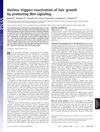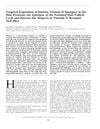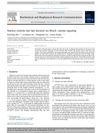A Unique Insertion/Duplication in the VDR Gene That Truncates the VDR Causing Hereditary 1,25-Dihydroxyvitamin D-Resistant Rickets Without Alopecia
October 2006
in “
Archives of Biochemistry and Biophysics
”
TLDR A unique gene mutation causes vitamin D-resistant rickets without causing hair loss.
The study described a unique case of hereditary vitamin D resistant rickets (HVDRR) caused by a novel 102 bp insertion/duplication mutation in the VDR gene, leading to a truncated VDR protein. This mutation resulted in resistance to 1,25-dihydroxyvitamin D3 but did not cause total body alopecia, unlike other similar cases. The truncated VDR retained the ability to bind DNA and interact with the corepressor hairless (HR), suggesting these interactions might regulate hair growth and skin health independently of ligand binding and coactivator interactions. The findings indicated that VDR might regulate hair growth through mechanisms that do not require ligand binding or coactivator interactions, as the patient exhibited patchy hair growth despite the mutation.





